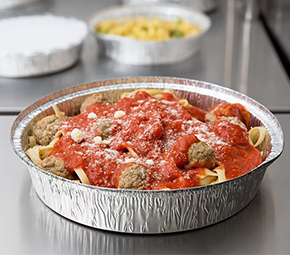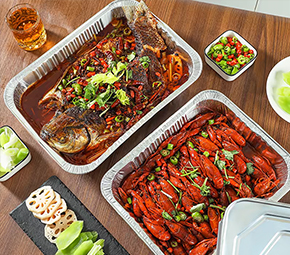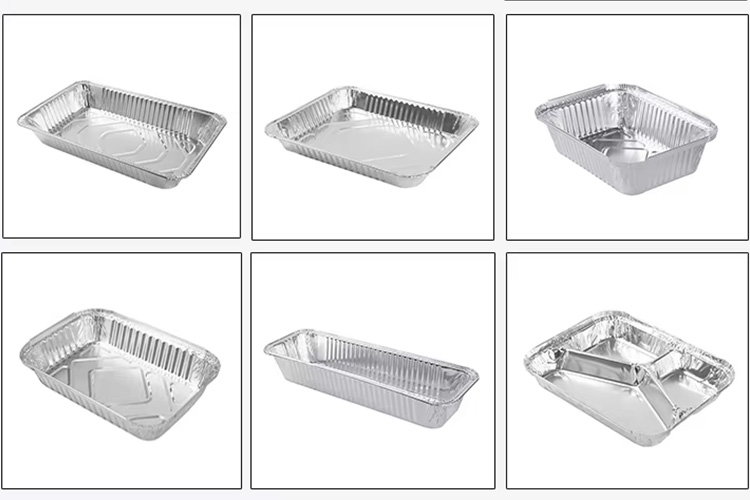
Common tin foil food containers specification
| MODEL | AC1713 |
| CAPACITY | 550ML |
| TOP OUT | 170*134MM |
| TOP IN | 155*118MM |
| BASE | 130*100MM |
| HIGHT | 44MM |
| MODEL | AC1814 |
| CAPACITY | 650ML |
| TOP OUT | 186*137MM |
| TOP IN | 168*122MM |
| BASE | 145*97MM |
| HIGHT | 48MM |
| MODEL | AC1912 |
| CAPACITY | 630ML |
| TOP OUT | 200*129MM |
| TOP IN | 182*113MM |
| BASE | 153*82MM |
| HIGHT | 49MM |
Coating: Although many brands cover the inside of the foil with a non-stick layer to help prevent food from sticking and clean up afterward. Usually, silicone and BPA-free non-stick coatings are used.
Closure use: tin foil food containers seal and keep food fresh through folding or crimping. Read more Some have adhesive strips or flaps for sealing. Heat resistance: tinfoil containers can tolerate 400°F/200°C for brief stretches of time that they are safe to use with hot food.
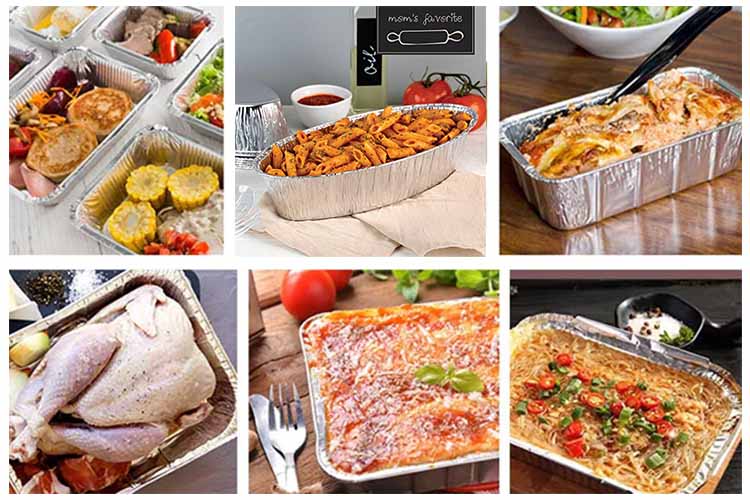
Tin foil containers have several benefits compared to other food packaging materials:
Cost: Foil is cheap to produce, and this, therefore, saves the cost of the container, especially when contrasted with the cost of reusable plastic containers.
Disposable: Because with foil packaging you only need to throw them away after being used, there are no dirty dishes, and consequently no washing up afterwards.
Portability: Leakproof, when crimped correctly, tin foil plate won’t leak juice or sauce like paper or thin plastic bags. Leakage is minimized.
They weigh 4 ounces, are fully recyclable, and can be neatly packaged while taking up space to transport food to wherever you need it.
Microwave and oven safe (in moderation): As explained earlier, tin foil plate tolerate short exposures of high temperatures from the microwave when you're heating leftovers. It's a throwaway, not reusable or recyclable like most disposables. But then, its production processes are friendlier than synthesizing plastics.
The vast majority of foil containers consumed in the Middle East are produced locally by HTMM, a specialist aluminum packaging company based in China. Here’s a brief overview of its production processes:
HTMM sources its material in the form of premium, high-purity aluminum coils from leading suppliers worldwide.
-Slitting: The modern slitting lines will be used to slit coils to the required widths for lids and container bodies.
The shapes are punched using dies on the sheet of aluminum.
Forming: Shallow drawing is used for making aluminum sheet into shaped body parts of the container while folding lids. Machining involves the use of deep drawing and computerized machines.
Non-stick coating: Thin non-toxic coat on selected surfaces is applied through a dedicated line for this purpose.
Packaging: After the containers are fully formed, counted, strapped, and placed in cartons, they are ready for distribution.
Aluminum Foil Contianer Quality Control:
At each stage, the process is under intense scrutiny to deliver a uniform and safe product.
This swift and efficient method allows HTMM to deliver over 4 billion eco-friendly, BPA-free aluminum foil trays to the Middle East region annually. With advanced production capabilities and regional proximity, HTMM holds a competitive advantage in the market.
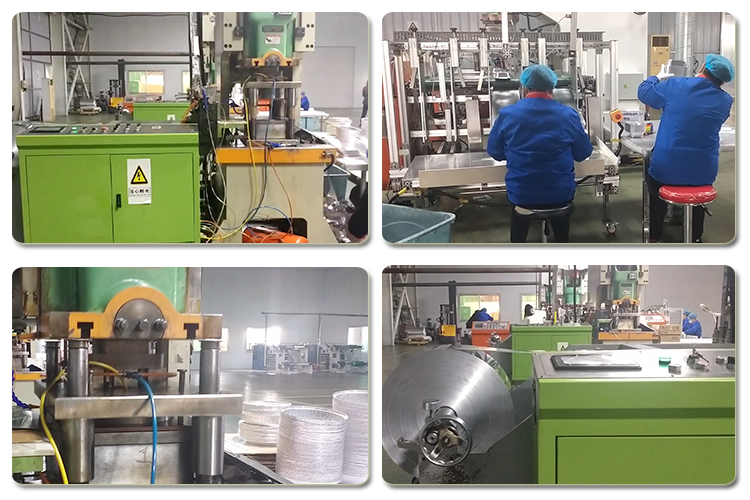
Q: What types of lunch boxes does HTMM manufacture?
A: HTMM produces a wide variety of aluminum foil lunch boxes designed to serve different purposes. Some of their widely produced lunch box lines include:
Bento Boxes: These rectangular lunch boxes have sections for easy organization of separate foods such as proteins, grains, vegetables etc. The sections prevent mixing of foods while keeping them fresh. HTMM produces bento boxes with 3-6 sections.
Round Lunch Boxes: For the traditionalists, some prefer round lunch boxes. HTMM round boxes come in one and two-section types. The two-section boxes are good for keeping wet and dry foods separate.
Leak Proof Lunch Boxes: Ideal for foods that tend to spill or leak like soups. These boxes come with tight seals and reinforced construction to prevent spillage or leaking. They keep the food fresh while being carried in bags.
Insulated Lunch Boxes: Are great for serving hot or cold dishes. Their insulated walls keep the temperature inside for several hours. These are available with or without freezer packs or heating elements, as per requirement.
Kids Lunch Boxes: Smaller sizes with funky designs like cartoons, vehicles, etc., to attract children. Some have a plastic lining to aid easy washing. The divided ones help kids learn to eat a balanced meal.
Collapsible Lunch Boxes: They are saving space boxes that can collapse to flatten for easy storage. They pop open easily when needed, while at the same time facilitating transport for a lunch on the go.
Q: What materials are used in HTMM lunch boxes?
A: HTMM lunch boxes are all made of high-grade aluminum foil. Aluminum foil is extremely versatile in nature and has many advantages in making lunch boxes:
Lighter: Aluminum foil is lighter as compared to other materials like stainless steel, thus making it easy to carry lunch boxes throughout the day.
Flexible: Aluminum foil is malleable, allowing HTMM to design boxes of different sizes and shapes. It allows the boxes to combine into a neat design when not in use.
Non-toxic: Aluminum foil has no harmful chemicals, being 100% BPA-free and FDA-approved food-safe.approved. Users can feel safe storing and reheating food in these boxes.
Not easy to penetrate: Aluminum foil can form a good diaphragm to prevent moisture and gas from passing through and isolate oxygen, which can extend the shelf life of food.
Easy to clean: The surface of aluminum foil is smooth and can be gently wiped clean with a damp cloth. Some aluminum foil lunch boxes have some removable plastic pads that can be completely cleaned.
High cost performance: Compared with other materials, aluminum foil allows HTMM to produce extremely cost-effective, inexpensive and high-quality aluminum foil lunch boxes.
Q: How long can food be kept fresh in aluminum foil lunch boxes produced by HTMM?
A: Putting food in aluminum foil lunch boxes produced by HTMM can extend the shelf life of food
For example, meat and protein can be kept fresh in the refrigerator for about five days. Aluminum foil can prevent the smell of different foods in the refrigerator from mixing.



